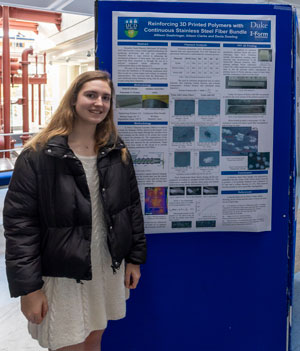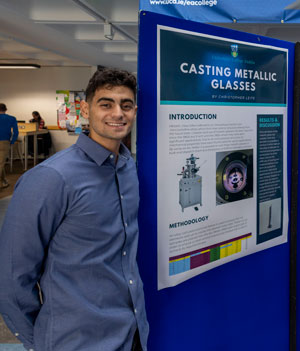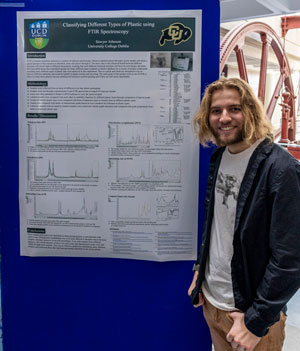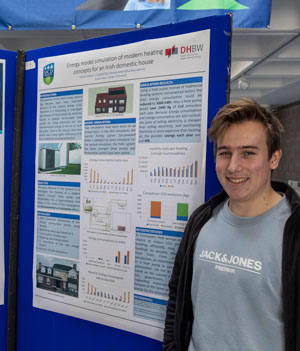.jpg) |
Allison Williams from the University of Alabama worked with Dr Kevin Nolan from the School of Mechanical & Materials Engineering and Dr Roderick Jones from the School of Chemical & Bioprocess Engineering on a project titled Sensor Package to Promote Offshore Security. This is a proposed sensor package that serves to promote security off of Ireland’s coasts, relaying accurate, up-to-date information in real time while being compact and cost-effective. |
.jpg) |
Caleb Burks from the University of Alabama worked with Dr Kevin Nolan from the School of Mechanical & Materials Engineering on The Effect of Spatial Cutoff Geometry on Schlieren: Visualisation of Thermal Plumes. Schlieren imaging is a powerful optical technique used to visualise variations in refractive index within transparent media, such as air. These variations often arise from temperature or pressure gradients, such as those found in convective heat flow. |
.jpg) |
Courtney Peterson from Penn State University was supervised by Dr Jufan Zhang from the School of Mechanical & Materials Engineering on a project, Enhancing Stage Range via Mechanical Redesign. Microneedle technology represents a cutting-edge advancement in transdermal drug delivery, offering a less invasive and more accessible alternative to traditional injection methods. |
.jpg) |
Devin Von Arx from Rice University worked with two PhD students and Trinity College Dublin on the Early Detection of Pulmonary Fibrosis Using Digital Stethoscope Audio and Signal Processing. Digital stethoscopes capture inaudible sound frequencies, offering a new opportunity for screening. The project investigates whether audio recordings from a digital stethoscope can be used to detect pulmonary fibrosis earlier using signal processing and machine learning techniques. |
.jpg) |
Georgia Herr from the University of Alabama worked with Dr James O’Donnell from the School of Mechanical & Materials Engineering on a project titled Evaluating Carbon Dioxide Heat Pump for Residential Use Utilising a Building Energy Performance Simulation. Carbon dioxide heat pumps are an emerging heat pump technology that utilises carbon dioxide as a refrigerant instead of a traditional hydrofluorocarbon refrigerant. CO2 heat pumps have several potential benefits. |
.jpg) |
Jessica Bressman from Princeton University worked with Dr Md Salauddin from the School of Civil Engineering on a project Investigating the Impact of Seagrass Species on Coastal Resilience. Coastal resilience becomes increasingly important as climate change progresses, and unnatural engineered solutions have proven to be economically and sustainably infeasible. |
.jpg) |
Joseph Duarte from the University of Notre Dame worked with Dr Javad Zeinali from the School of Mechanical & Materials Engineering on a project titled Satellite Imagery Detection Neural Network Through Generative AI. The rise of Generative AI tools, such as the LLM ChatGPT, has introduced new possibilities for enhancing everyday coding projects. Developers now use AI to generate boilerplate code, suggest function improvements, automate documentation, and even simulate user interaction for interface testing. |
.jpg) |
Leah Kanzler from Case Western Reserve University worked with Dr Kevin Nolan from the School of Mechanical & Materials Engineering on a project, Bridging Engineering and Extended Reality Using the 2D Heat Equation. To delve into this idea, this project focuses on a simple physics concept and explores ways in which to make it interactive in order to create a more fundamental understanding while also portraying it in an engaging way. |
| Olivia Hall from Columbia University worked with Dr Kevin Nolan from the School of Mechanical & Materials Engineering on a project around Optimising AUV Deployment using Finite-Time Lyapunov Exponents from Ocean Flow Data Off the Irish Coast. Approximately 97% of all global data passes through undersea cables: fibre-optic cores that facilitate emergency services, commerce, and military operations worldwide, and Ireland’s position off the mainland of Europe makes it so that 75% of transatlantic cables travel through Irish waters. |
|
.jpg) |
Ryan Leavy from the University of Michigan worked with Dr Kevin Roche from the School of Mechanical & Materials Engineering, comparing 3D CT Scans and Photogrammetry Models of Fish Jaws. The goal of this particular study was to compare the results of these methods from various sets of fish jaws to determine how similar they are and if photogrammetry could be used instead of CT scans, since it is cheaper and simpler to use. |
| Samantha Feldman from Washington University, St Louis, worked with Dr Vikram Pakrashi from the School of Mechanical & Materials Engineering on a Vortex-Induced Vibrations and Impact Displacement Response project. Vortex-induced vibration (VIV) of a cylinder has been thoroughly studied and documented over the course of the past fifty years. VIV was known as a destructive phenomenon, and researchers attempted to decrease the harmful energy that could cause failures in engineering assemblies. |
|
.jpg) |
Samuel Roth from Syracuse University worked with Dr Kevin Nolan from the School of Mechanical & Materials Engineering, titled Why Not Blender? Comparative Study of Blender and ANSYS for Educational Airflow Modelling. This project poses a simple question: If a company like Pixar can simulate realistic airflow for animation, why can't engineers utilise similar streamlined tools for educational purposes that don’t require the greatest precision? |
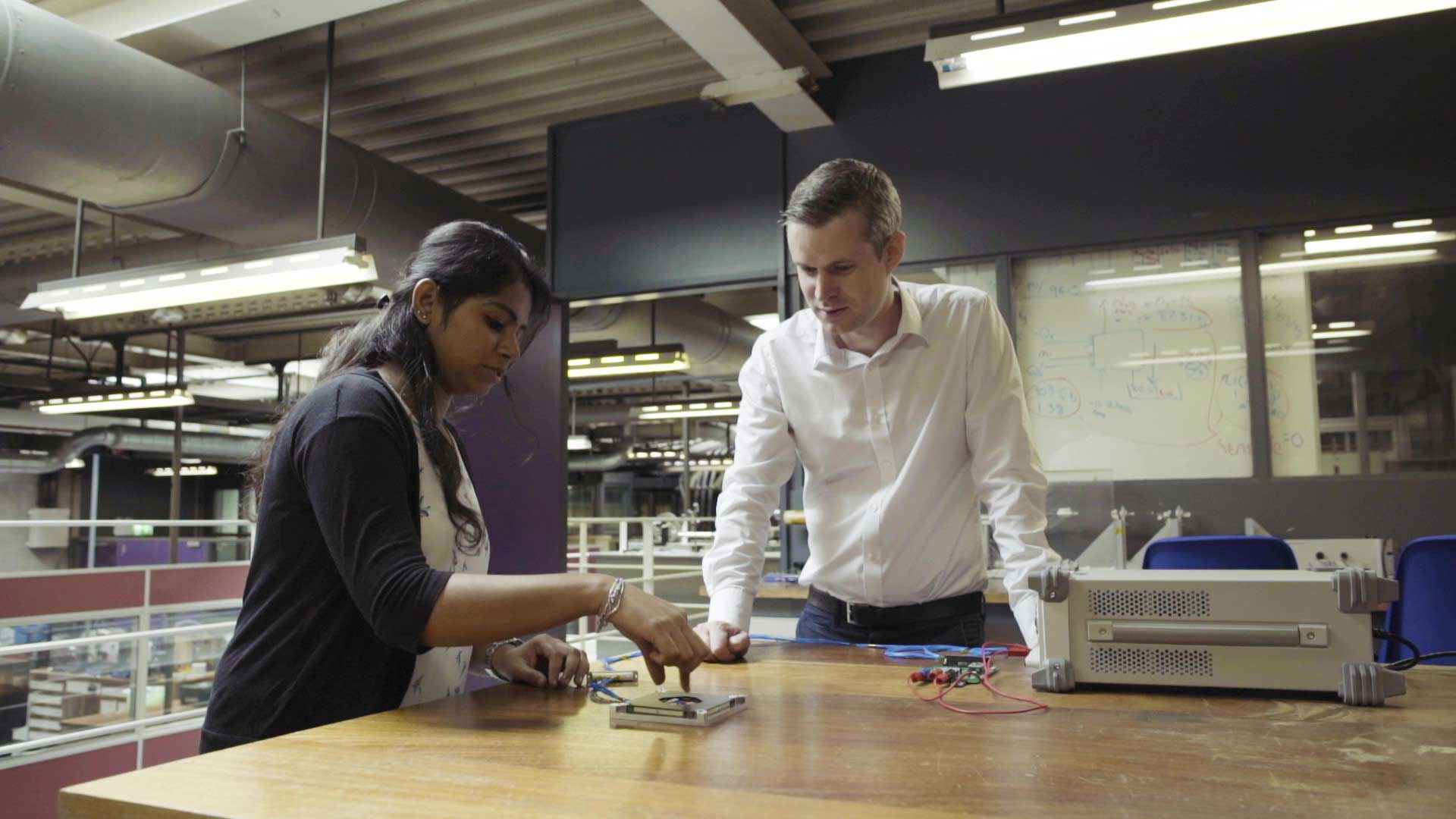

Introduction to Engineering Research Module
The MEEN30170 (opens in a new window)Introduction to Engineering Research module is available exclusively to UCD Engineering Study Abroad students.
This module introduces students to the principles of engineering research through attachment to an active research group in the College of Engineering & Architecture. Students will become active members of a research group and work under the direction of the group’s Principal Investigator. Students will learn about the research focus of the group and conduct independent research into the scientific literature relevant to the group’s activity. They will shadow a member of the research team and carry out a research project encompassing one or more engineering capabilities.
Based on the research activity of the research group, students will learn about research methodologies and what is needed to progress basic research ideas towards higher technology readiness levels. Using data generated by themselves and/or the group, students will learn how to analyse the research data and communicate their findings effectively and take appropriate action. Students will also learn how to write a scientific abstract and a scientific report, as well as how to make a scientific presentation in the context of engineering research.
Examples of Research Projects
 |
Aizhan Moore from Syracuse University worked with Dr Ronan Cahill from the UCD School of Medicine and Dr Kevin Nolan, UCD School of Mechanical & Materials Engineering, on a project Developing Wireless Interface devices for Real-Time Surgical Interaction with Computer Systems during fluorescence-guided procedures. |
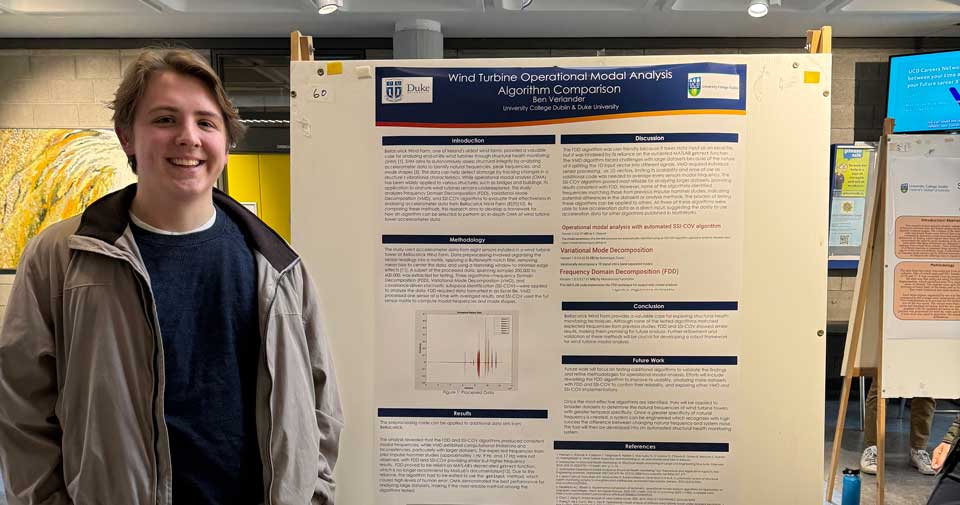 |
Ben Verlander from Duke University was supervised by Dr Vikram Pakrashi from the UCD School of Mechanical & Materials Engineering on a project titled Wind Turbine Operational Modal Analysis Algorithm Comparison. |
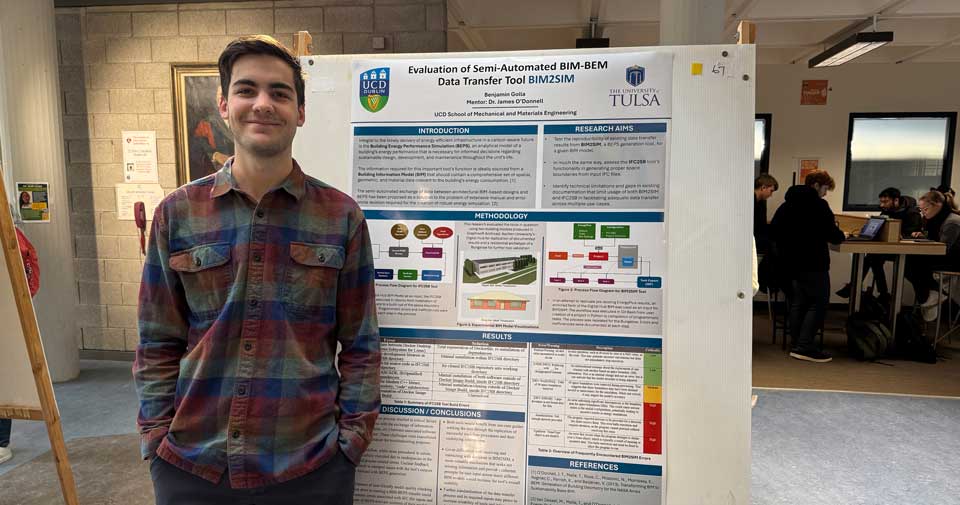 |
Benjamin Golla from the University of Tulsa worked with Dr James O’Donnell from the UCD School of Mechanical & Materials Engineering on a project titled the Evaluation of Semi-Automated BIM-BEM Data Transfer Tool BIM2SIM. |
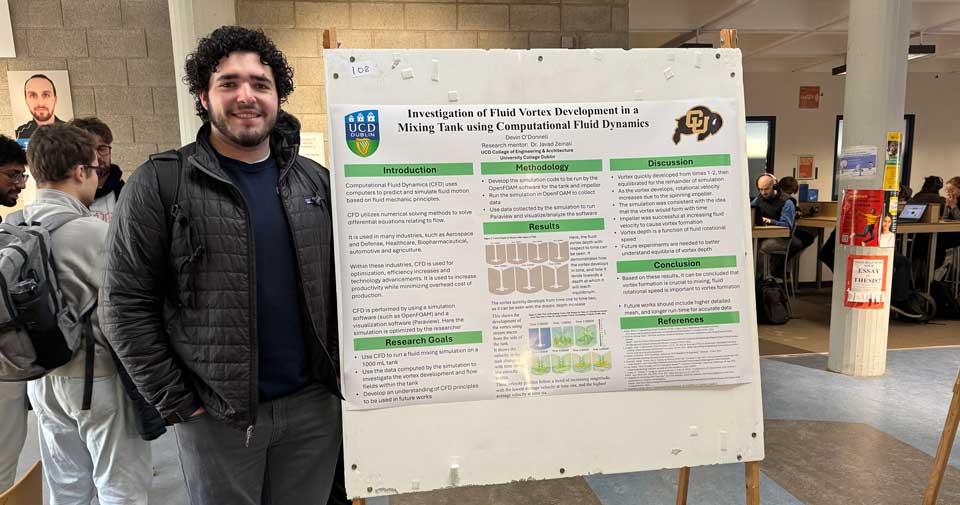 |
Devin O’Donnell from the University of Colorado, Boulder, worked with Dr Javad Zeinali from the UCD School of Mechanical & Materials Engineering on a project titled Investigation of Fluid Vortex Development in a Mixing Tank using Computational Fluid Dynamics. |
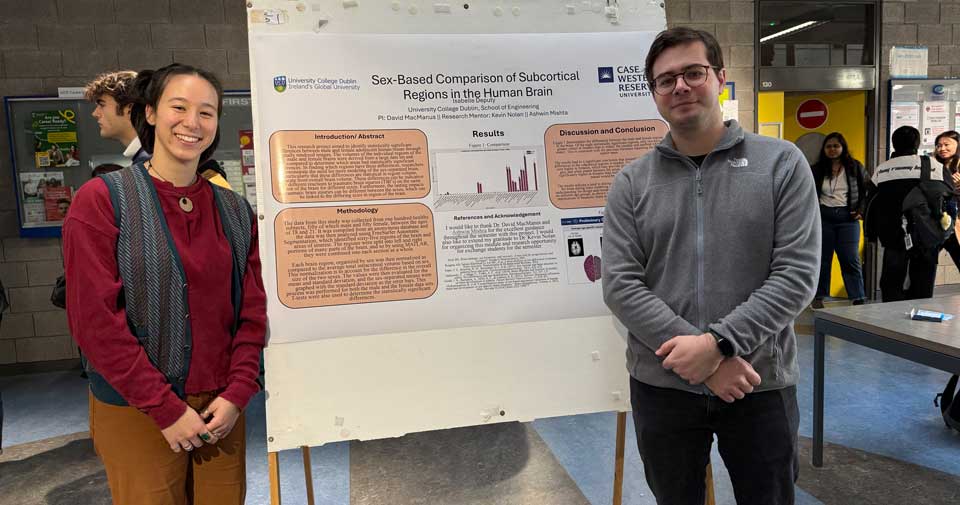 |
Isabelle Deputy from Case Western Reserve University worked with Dr David MacManus and Ashwin Mishta, UCD School of Mechanical & Materials Engineering on a project titled Sex-Based Comparison of Subcortical Regions in the Human Brain. |
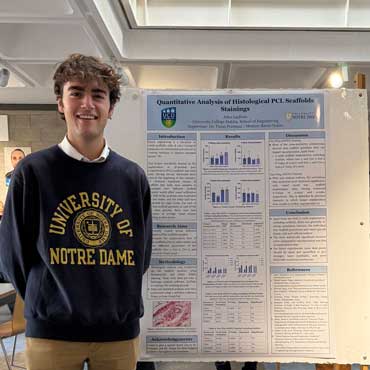 |
John Gadbois from the University of Notre Dame was supervised by Dr Fiona Freeman from the UCD School of Mechanical & Materials Engineering. John’s project was titled Quantitative Analysis of Historical PCL Scaffolds Stainings. |
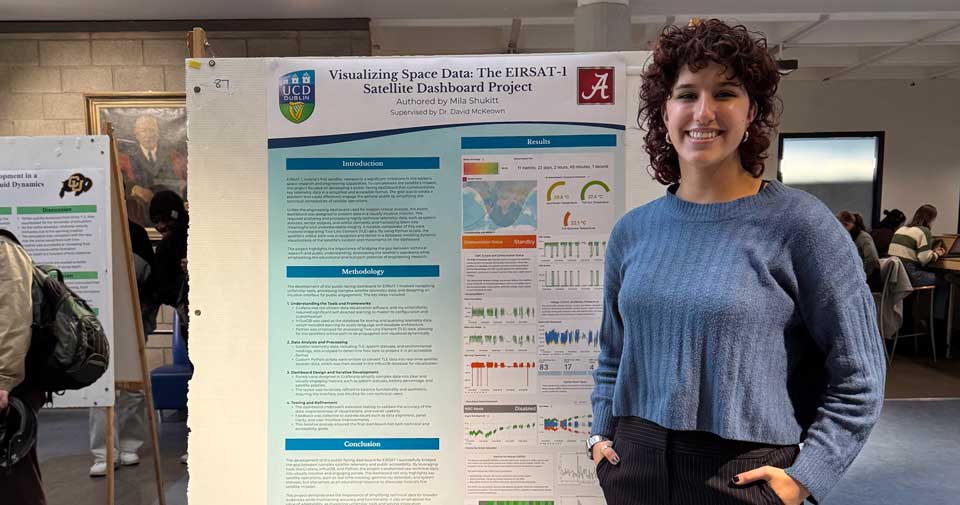 |
Mila Shukitt from the University of Alabama worked with Dr David McKeown from UCD School of Mechanical & Materials Engineering on a project titled Visualising Space Data: The EIRSAT-1 Satellite Dashboard Project. |
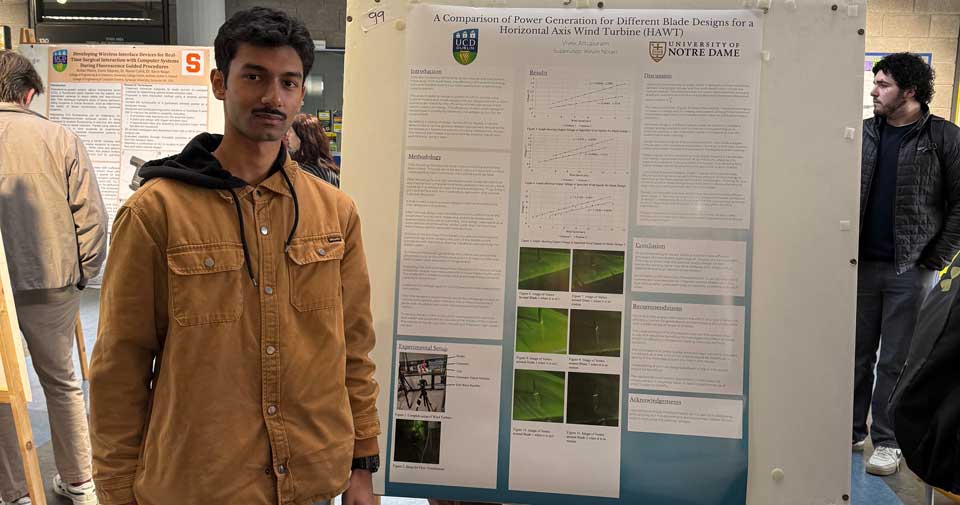 |
Vivek Attupuram from the University of Notre Dame was supervised by Dr Kevin Nolan from the UCD School of Mechanical & Materials Engineering. Vivek’s project was titled A Comparison of Power Generation for Different Blade Designs for a Horizontal Axis Wind Turbine (HAWT). |
 |
Andrew Johnson from Washington University, St Louis, worked with Dr Mark Pickering from the UCD School of Medicine on a project, Measuring Microplastics in Oceans via Impedance Spectroscopy. Andrew’s research aims to use readily available materials to design a mass-producible method of detecting microplastics in Earth’s oceans that can be validated by existing methods. |
| Lucy Lin from the University of Pennsylvania worked with Dr Philip Cardiff from the UCD School of Mechanical & Materials Engineering on a project titled the Characterisation of Mechanical Properties of Rubber Bands in Various Configurations. This study draws inspiration from the Rainbow Loom bands, where basic series patterns exhibit high elasticity, while advanced patterns like fish-tails or hexa-fish are sturdier and less stretchable due to their configurations. The motivation for this project is to understand the mechanical properties of rubber bands in different configurations – series, parallel, and hybrid – using a Material Testing System (MTS) machine. | |
| David D’Alessando from Washington University, St Louis, was supervised by Dr. Kevin Nolan from the UCD School of Mechanical & Materials Engineering on a project titled CFD Analysis of a Formula One Car to Determine the Halo’s Effect on the Car’s Performance. In 2018, Formula One mandated that the halo, a ring-shaped frame mounted above the driver’s head in the cockpit, be implemented to increase drivers’ safety. | |
| Gabriela Kogler from Washington University, St Louis was supervised by Dr. Adam Boyce on a project titled The Solid Mechanics of Solid-State Lithium-ion Batteries from Changing the Charge Rate and Elastic Modulus of the Electrolyte within the Cell. The increasing need for energy storage solutions has spurred demand for high-performance, long-lasting, and low-cost batteries, with solid-state batteries (ASSBs) emerging as a promising alternative to lithium-ion batteries due to their safety and potential for high energy density. | |
| Matthew Cheifetz from Washington University, St Louis, supervised by Dr. Kevin Nolan from the UCD School of Mechanical & Materials Engineering, carried out An Analysis of a ball suspended by a jet of air using high-speed schlieren. The objective of this experiment was to better understand why a ball levitates when exposed to a jet of air from below. More specifically, an investigation was conducted about the airflow properties and patterns that contribute to this levitation effect. | |
| Olivia Landriscina from George Washington University was supervised by Professor Peter Kennedy from the UCD School of Electrical & Electronic Engineering on a project based on Digital Delta Sigma Modulators and MASH Equations. The first step in understanding what DDSMs are is understanding what DSMs are in general. A delta-sigma modulator is an electronic circuit used to convert analogue signals into digital data. | |
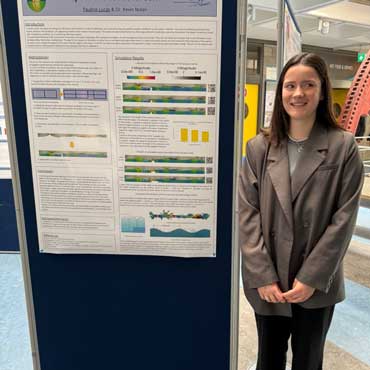 |
Pauline Lucas from ECAM Rennes, France, was supervised by Dr. Kevin Nolan from the UCD School of Mechanical & Materials Engineering. Her project is titled Flow measurement Application: spot wave device for Surf. In recent years, the sport of surfing has attracted a phenomenal number of adherents, but its practice requires specific weather conditions on the coasts. However, new solutions allowing surfing all year round, whatever the conditions, are appearing thanks to the creation of wave pools. |
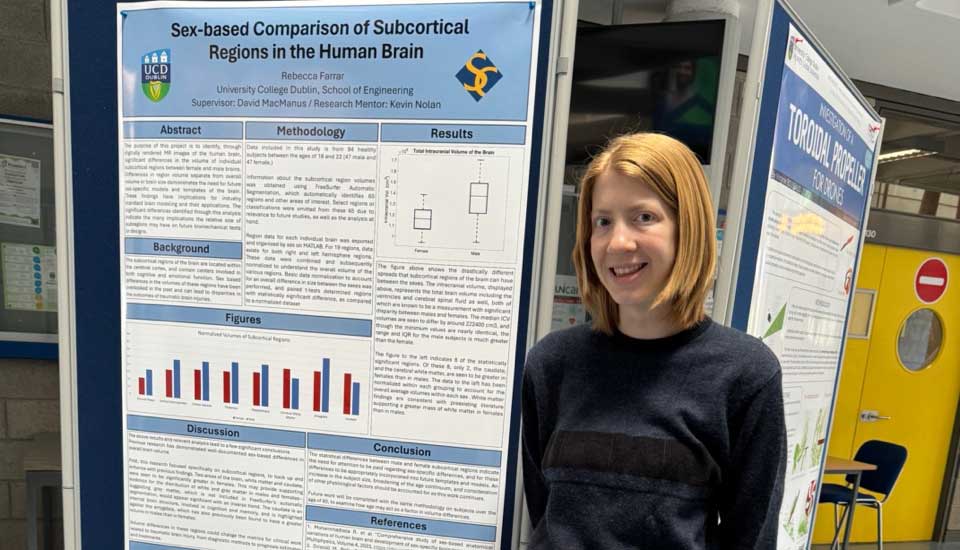 |
Rebecca Farrar from Smith College worked on a Sex-based Comparison of Subcortical Regions in the Human Brain under the supervision of Dr David MacManus from the UCD School of Mechanical & Materials Engineering. The purpose of this project is to identify, through digitally rendered MR images of the human brain, significant differences in the volume of individual subcortical regions between female and male brains. |
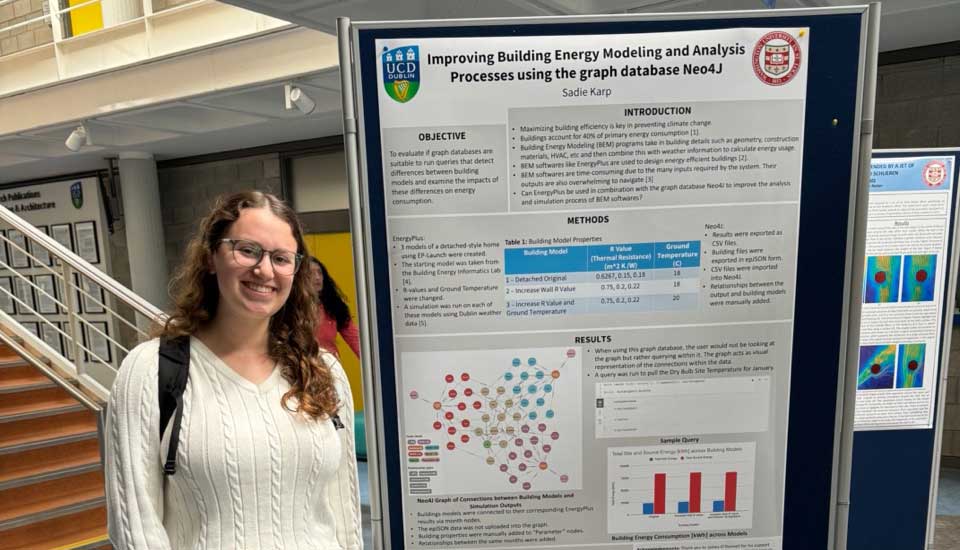 |
Sadie Karp from Washington University, St Louis, worked on a project titled Improving Building Energy Modelling and Analysis Processes using the graph database Neo4J under the direction of Dr James O’Donnell from the UCD School of Mechanical & Materials Engineering. The objective of the project is to evaluate whether graph databases are suitable for running queries that detect differences between building models and examine the impacts of these differences on energy consumption. |
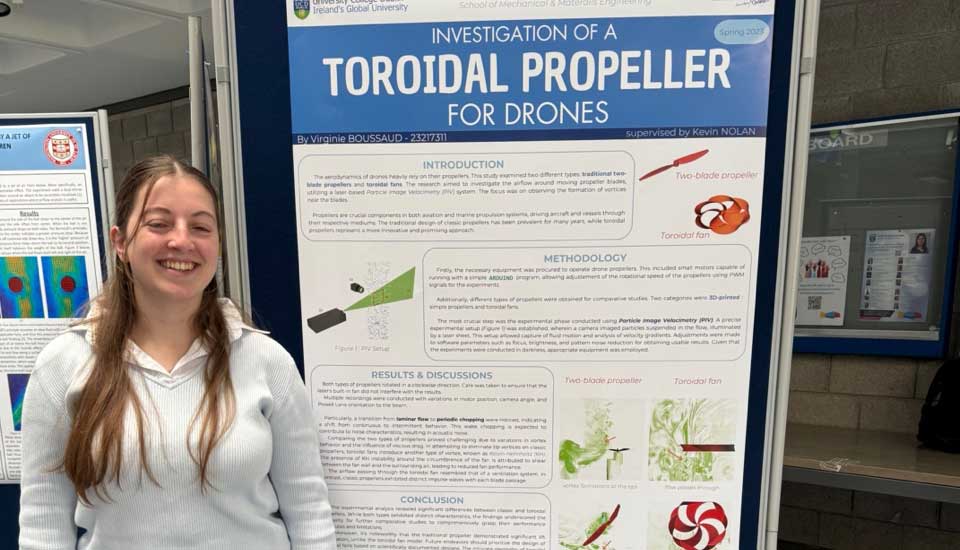 |
Virginie Boussard from ECAM Rennes, France, investigated the toroidal propeller for drones with Dr. Kevin Nolan from the UCD School of Mechanical & Materials Engineering. The aerodynamics of drones heavily rely on their propellers. This study examined two different types: traditional two-blade propellers and toroidal fans. The research aimed to investigate the airflow around moving propeller blades, utilising a laser-based Particle Image Velocimetry (PIV) system. |
| Yasmein Asfour from George Washington University worked under the guidance of Professor Nikolaos Papakostas from the UCD School of Mechanical & Materials Engineering on a project titled Automated Counting and Inspection System. This project centres on automated counting and inspection tasks in manufacturing using the Intel RealSense D455 camera, a robotic arm, and MATLAB. Provided with a pallet of drills from the ATA Drills group, the objective is twofold: firstly, to develop a method for accurately counting the drills, and secondly, to identify any defects present. | |
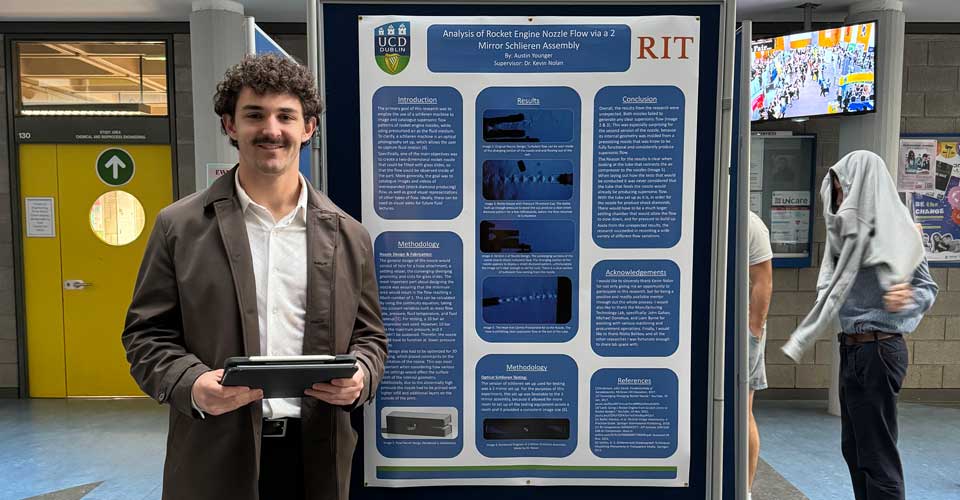 |
Austin Younger from Rochester Institute of Technology worked with Dr Kevin Nolan from the UCD School of Mechanical & Materials Engineering on a project that analysed rocket engine nozzle flow via a 2-mirror schlieren assembly. The primary goal of this research was to employ the use of a schlieren machine to image and catalogue supersonic flow patterns of pocket engine nozzles, while using pressurised air as the fluid medium. |
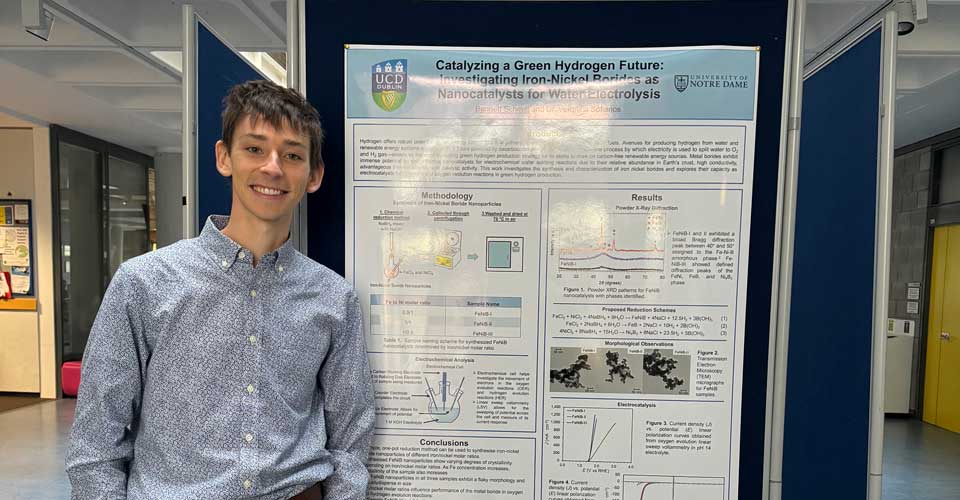 |
Bennett Schmitt from the University of Notre Dame worked with Dr Veronica Sofianos from the UCD School of Chemical & Bioprocess Engineering on a project to catalyse a Green Hydrogen Future: Investigating Iron-Nickel Borides as Nanocatalysts for Water Electrolysis. His work investigates the synthesis and characterisation of iron nickel borides and explores their capacity as electrocatalysts for hydrogen and oxygen evolution reactions in green hydrogen production. |
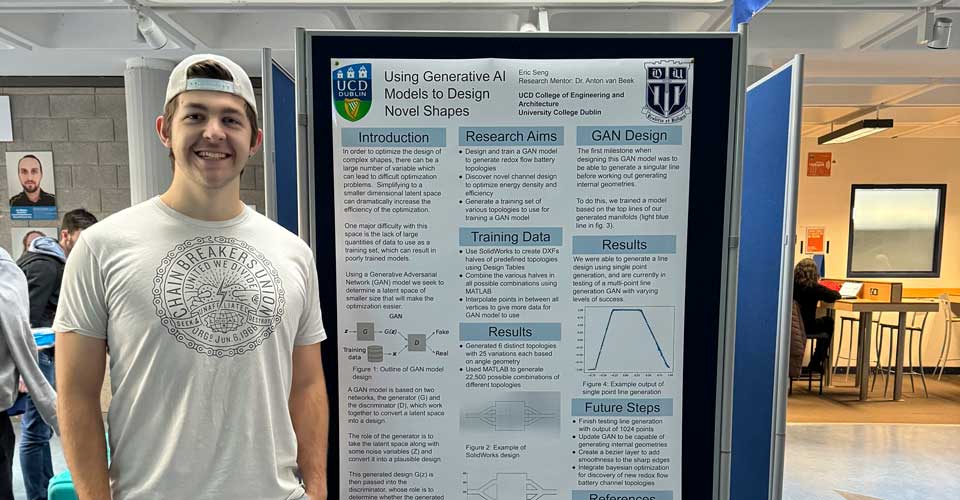 |
Eric Seng from Duke University worked with Dr Anton van Beek from the UCD School of Mechanical & Materials Engineering on a project using Generative AI Models to Design Novel Shapes. In order to optimise the design of complex shapes, there can be a larger number of variables, which can lead to difficult optimisation problems. Simplifying to a smaller dimensional latent space can dramatically increase the efficiency of the optimisation. |
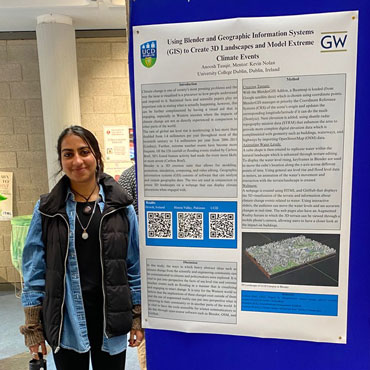 |
Anoosh Tauqir from George Washington University worked with Dr Kevin Nolan from the UCD School of Mechanical & Materials Engineering on a project titled Using Blender and Geographic Information Systems (GIS) to Create 3D Landscapes and Model Extreme Climate Events. In this study, the ways in which heavy abstract ideas, such as climate change, from the scientific and engineering community can be communicated to citizens and policymakers were explored. |
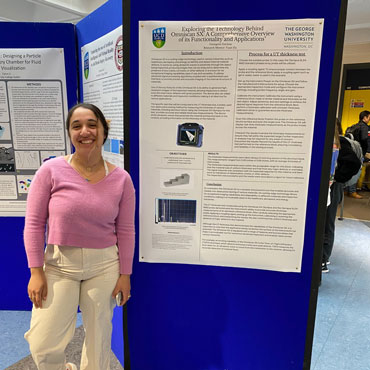 |
Georgette Encinas from George Washington University worked with Dr Yuan Hu from the UCD School of Mechanical & Materials Engineering on a project, Exploring the Technology behind Omniscan SX: A Comprehensive Overview of its Functionality and Applications. |
 |
Emma Kroll from Washington University, St Louis, worked with Professor Lizbeth Goodman from the UCD School of Mechanical & Materials Engineering on a project, Exploring the use of Artificial Intelligence and Virtual Reality to Aid Brain Injury Recovery. With the rise of Artificial Intelligence (AI) and Virtual Reality (VR), we are just scratching the surface of how we can use these technologies to aid the population. |
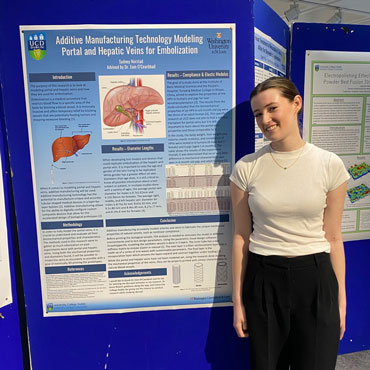 |
Sydney Norstad from Washington University, St Louis, worked with Dr Eoin O'Cearbhaill from the UCD School of Mechanical & Materials Engineering on a project on Additive Manufacturing Technology Modelling Portal and Hepatic Veins for Embolisation. Embolisation is a medical procedure that restricts blood flow to a specific area of the body, such as a tumour, by blocking a blood vessel. |
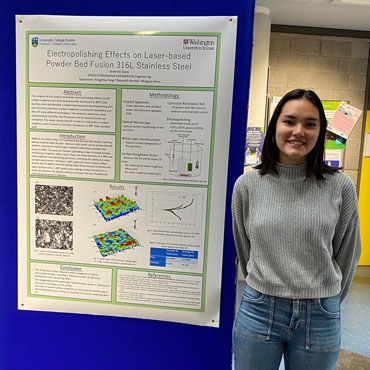 |
Jasmine Davy from Washington University, St Louis, worked with Professor Fengzhou Fang and Research Mentor Mingyue Shen from the UCD School of Mechanical & Materials Engineering on a project around the Electropolishing Effects on Laser-based Powder Bed Fusion 316L Stainless Steel. |
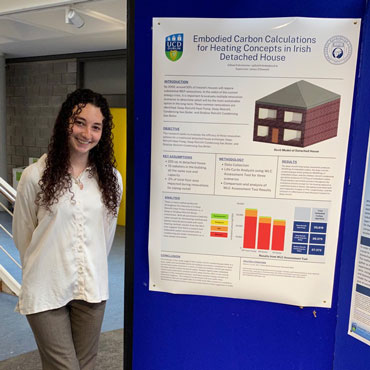 |
Gillian Fuhrmeister from George Washington University worked with Dr James O'Donnell from the UCD School of Mechanical & Materials Engineering on a project which evaluated Embodied Carbon Calculations for Heating Concepts in an Irish detached house. |
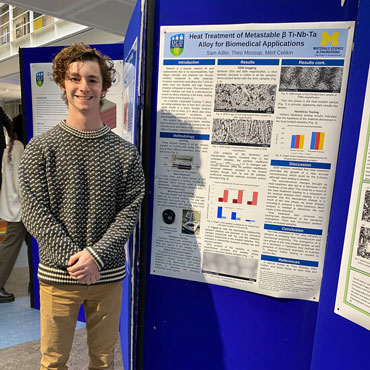 |
Samson Adler from the University of Michigan worked with Dr Mert Celikin and Research Mentor Theo Mossop from the UCD School of Mechanical & Materials Engineering on a project around the Heat Treatment of Metastable β Ti-Nb-Ta Alloy for Biomedical Applications. |
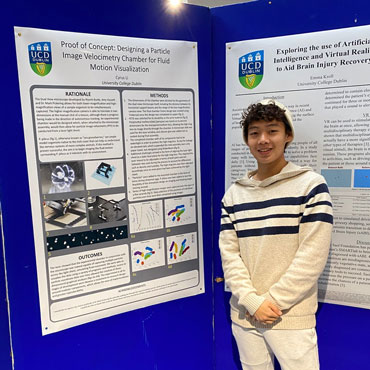 |
Cyrus Li from Virginia Tech worked with Dr Mark Pickering from the UCD School of Medicine on a project titled Proof of Concept: Designing a Particle Image Velocimetry Chamber for Fluid Motion Visualisation. |
|
|
Allison Goehringer from Duke University worked with Prof Denis Dowling and Alison Clarke from the UCD School of Mechanical & Materials Engineering on a project titled Reinforcing 3D Printed Polymers with Continuous Stainless Steel Fibre Bundle. The goal of this project was to investigate for the first time the feasibility of 3D printing continuous steel fibre ex-situ in a nylon matrix and evaluate its material characteristics. |
|
|
Christopher Leite from Stevens Institute of Technology worked with Prof David Browne from the UCD School of Mechanical & Materials Engineering on a project titled CASTING METALLIC GLASSES. Due to its noncrystalline structure, its mechanical properties have been found useful for space applications. |
|
|
Sawyer Johnson from the University of Colorado, Boulder, worked with Dr Kevin Roche from the UCD School of Mechanical & Materials Engineering on a project titled Classifying Different Types of Plastic using FTIR Spectroscopy. The main goals of this project were to see if FTIR is effective when these plastics become multilayered and have exterior printing, and if they are still easily identifiable. |
|
|
Florian Kisters from DHBW, Stuttgart, worked with Dr James O'Donnell from the UCD School of Mechanical & Materials Engineering on a project titled Energy model simulation of modern heating concepts for an Irish domestic house. The question of the energy systems used has become even more important because of the current energy crisis. Therefore, it is interesting to investigate the chances of heat pumps for domestic houses in Ireland. |
Alanis Wilson-Ehrenthal from University of Colorado, Boulder worked with Dr Vincent Hargaden from the UCD School of Mechanical & Materials Engineering on a project titled DesignPlan: Graphical User Interface Prototype. It entailed an educational tool for use of facility layout planning software’s and the literature review and development of GUI prototype.
Click to download Alanis Wilson-Ehrenthal Poster Presentation
Brendan Kornatz from Vanderbilt University worked with Dr Kevin Nolan and Dr Luca Biancofiore from the UCD School of Mechanical & Materials Engineering on a project titled Viscoelasticity Characterization. His research covered an experiment done to characterize the torque, shear-rate, and other attributes of two non-Newtonian fluid mixtures, in order to help computers model non-Newtonian fluids.
Click to download Brendan Kornatz Poster Presentation
Carly Ward from Syracuse University worked with Dr Kevin Nolan and Dr Conan McCaul from the UCD School of Mechanical & Materials Engineering on a project titled Investigation into the Role of Tube Crimping in Medical Devices for Failed Epidural Analgesia. The goal of her research was to determine if any or enough crimping occurs within an epidural catheter that would cause complications using various catheter types.
Click to download Carly Ward Poster Presentation
Jack Ward from Washington University, St Louis worked with Dr Malachy O’Rourke from the UCD School of Mechanical & Materials Engineering on a project titled The Segmentation and Flow Velocity Visualization of Abdominal Aortic Aneurysm. The goal of his research was to gain familiarity with the segmentation and flow visualization of a patient with an abdominal aortic aneurysm using 3D Slicer and Ansys Fluent.
Click to download Jack Ward Poster Presentation
Jenna Rogge from Washington University, St Louis worked with Dr David McKeown from the UCD School of Mechanical & Materials Engineering on a project titled EIRSAT – 1 Thermal Analysis. EIRSAT-1 is the Educational Irish Research Satellite 1. It is a 2U CubeSat being developed as part of the European Space Agency's Fly Your Satellite programme.
Click to download Jenna Rogge Poster Presentation
Jonah Goldman from George Washington University worked with Dr Lizbeth Godman from the UCD School of Mechanical & Materials Engineering on a project titled Critical Review of Eye Tracking Technology in the Study of Autism. In order to successfully connect with children with autism, one of the most important keys in therapy is to hold their attention to reinforce skills like emotional mimicry and eye contact.
Click to download Jonah Goldman Poster Presentation
Kha Trinh from St Olaf College worked with Dr Niall English from the UCD School of Chemical & Bioprocessing Engineering on a project titled Molecular Dynamics Simulation of a new effective inhibitor for CO2 Hydrate Formation. This project aimed to qualitatively understand and examine the potency of TETA from the microscopic perspective with the assistance of molecular dynamics (MD) simulations.
Click to download Kha Trinh Poster Presentation
Zachary Shuler from Syracuse University worked with Dr Donal Holland from the UCD School of Electrical & Electronic Engineering on a project titled Modelling Pneumatic Inflatable Actuators (PIA). Pneumatic Inflatable Actuators (PIA) are devices that can be used in soft robotic actuators.
Click to download Zachary Shuler Poster Presentation
 |
Garrett DiRienz from Vanderbilt University worked with Ryan Paetzold and Dr Christopher Musgrave from the UCD School of Mechanical & Materials Engineering on a project titled Flexible Filament 3D Printing for Tensile Testing Equipment Validation. Tensile testing is a fundamental procedure for material testing, and a material’s tensile strength is widely used as a simple yet effective predictor for its behaviour. Read more about Garrett’s research output on his poster presentation. |
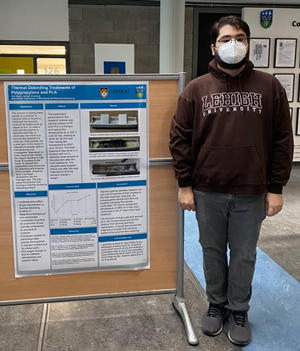 |
Eric Tkach from Lehigh University worked with Dr Mert Celikin from the UCD School of Mechanical & Materials Engineering on a project titled Thermal Debinding Treatments of Polypropylene and PLA. The concept of adding metal powder to a polymer to injection mould or 3d print a metal part has become common for metals such as copper or iron. Read more about Eric’s research participation in his poster presentation. |
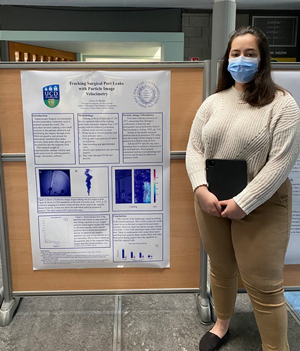 |
Grace Al-Sheikh from Syracuse University worked with Dr Kevin Nolan from the UCD School of Mechanical & Materials Engineering on a project titled Tracking Surgical Port Leaks with Particle Image Velocimetry. Laparoscopic Surgery is a minimally invasive procedure commonly used in hospitals around the world. The procedure involves making a few small incisions in the patient’s abdomen and performing the surgery through ports. While designed to seal around the instruments inserted when under pressure, these ports often leak gases and particles into the surgeon’s field. This research sought to experimentally validate velocity and path projections by utilising particle image velocimetry software. |
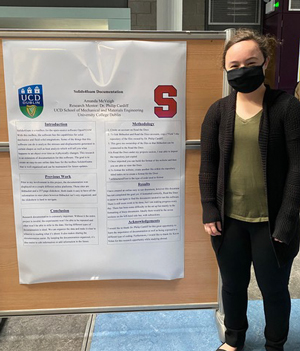 |
Amanda McVeigh from Syracuse University worked with Dr Philip Cardiff from the UCD School of Mechanical & Materials Engineering on a project titled Solids4foam Documentation. Solids4foam is a toolbox for the open-source software OpenFOAM. With this toolbox, the software has the capabilities for solid mechanics and fluid-solid integrations. This research is an extension of the documentation for this software. The goal is to create an easy-to-use online database for the toolbox Solids4foams that is well organised and can be maintained for future updates. |
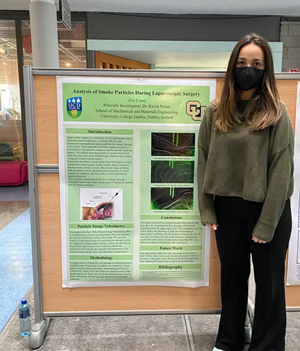 |
Zoe Cruse from the University of Colorado, Boulder, worked with Dr Kevin Nolan from the UCD School of Mechanical & Materials Engineering on a project titled Analysis of Smoke Particles During Laparoscopic Surgery. Laparoscopic surgery is a minimally invasive abdominal surgery where the patient’s abdomen is inflated with CO2 and specialised instruments are used to perform the surgery through a set of ports. This research examined the fluid flow of smoke through a simulated laparoscopic field with the goal of finding the optimal port for smoke extraction. |
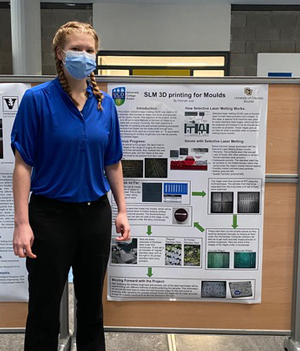 |
Hannah Juul from the University of Colorado, Boulder, worked with Prof Michael Gilchrist from the UCD School of Mechanical & Materials Engineering on a project titled SLM 3D printing for Moulds. For this project, selective laser melting (SLM) was used to 3D print stainless steel powder to make very small and accurate moulds for plastic inserts. The objective of the project, currently, is to 3D print micro features in the form of ridges on a base plate with accuracy. The main objective is to perfect the 3D printing and post-printing polishing processes to make sure that ridges can be made small enough and accurate enough to be used as a mould later. |
Josh Falejczyk, University of Alabama worked with Dr Paul Cuffe from the School of Electrical and Electronic Engineering on a project entitled "Exploring Spectrogram-based Audio Signal Representation and Synthesis". This research explored what occurs to an audio signal if its spectrogram data was extracted, converted from a raster representation to a vectorized one, and synthesized back into audio. The implications of this research may not only offer unique audio signal augmentations, but also alternative methods of audio signal storage. Josh will continue to collaborate with Dr Cuffe on this work going forward.
Click to download Josh_Falejczyk’s Poster Presentation (pdf).
Makenzie Ferguson, University of Alabama worked with Dr Kevin Nolan from the School of Mechanical and Materials Engineering. The project was entitled “Analysis of Gas Leakage during Laparoscopic Surgery”. Makenzie performed detailed post-processing of an extensive database of Schlieren video data of gas leaks during simulated surgery using porcine cadavers. The work was conducted in collaboration with surgeons from the Mater Misericordiae University Hospital and a manuscript is being prepared for publication.
Click to download Makenzie_Ferguson’s Poster Presentation (pdf).
Haley Barnes, Georgia Tech also worked with Dr Kevin Nolan from the School of Mechanical and Materials Engineering on a project entitled “CAD Modelling of a 3D Printed Solution to CO2 Leaks in Laparoscopic Surgery". Haley developed novel flow geometries for surgical trochars to passively divert gas leaks away from theatre staff to reduce risks associated with surgical smoke and aerosol. A theoretical analysis was conducted in conjunction with experimental measurements on a proof of concept device. Such a passive system would eliminate the need for active smoke management devices and reduce the workload on the surgical team.
Click to download Haley_Barnes' Poster Presentation (pdf).
Bianca Acot, Princeton University carried out her research in the laboratory of Professor Michael Gilchrist, UCD School of Mechanical & Materials Engineering. She did an analysis of traumatic brain injuries using Kinovea (Phase 1) and the University College Dublin Brain Trauma Model (Phase 2). Overall, Bianca’s project is an example of a methodology for performing forensic reconstructions of sports-related head impacts to improve helmet testing and elucidate the mechanics of traumatic brain injuries (TBIs). Bianca aims to continue her research under the mentorship of Professor Michael Gilchrist when she returns to Princeton and use her analysis on rugby head impacts using finite element for her undergraduate thesis project. Bianca continued her UCD work for her thesis when she returned to Princeton. Professor Gilchrist acted as her external advisor along with two academic advisers from Princeton.
Click to download Gabbie Acot’s Poster Presentation
Claire McFarland, Washington University St Louis carried out her research in the laboratory of Dr Nan Zhang, UCD School of Mechanical & Materials Engineering who is searching for the best method to print human cardiovascular vessels. Claire investigated the best method of cell depositing during the 3D printing process – bioprinting. Her research focused on four main processes; extrusion based; droplet-based; laser-based and digital light processing (DLP) and concluded that DLP was the most effective method.
Click to download Claire McFarland’s Poster Presentation
Taylor Chapman, Yale University carried out her research in the laboratory of Professor Andrew Keane, UCD School of Electrical & Electronic Engineering and Mr Michael Power, UCD Energy Institute. Taylor’s project focused on the documentation of energy management systems and the DUtrain power system handler. The goal of Taylor’s project was to provide documentation of the DUtrain PSH for users that included relevant background information, network set-up within the lab, and execution of network applications.
Click to download Taylor Chapman’s Poster Presentation
Dylan Logan, University of Massachusetts, Amherst carried out his research in the laboratory of Dr Nan Zhang, UCD School of Mechanical & Materials Engineering and analysed the capability and utility of open source motion tracking software Kinovea and blender for research application. Dylan’s work was motivated by his desire to find a suitable and capable motion tracking and modelling software that was offered open source. His goal was to find something robust that people could gain access to for free and could learn during schooling and it would still be practical for them after research.
Click to download Dylan Logan’s Poster Presentation
Hayden Simmons, Washington University St Louis carried out his project in the laboratory of Professor Lizbeth Goodman in the UCD School of Mechanical & Materials Engineering and Mr James O’Connor in the SMARTlab. Hayden explored the viability of utilizing smart home devices in aiding communication with patients with Locked in Syndrome (LIS). Smart home devices are those that use the internet and various non-physical switches to function. For example, the popular Amazon Alexa enables its users to activate connected devices by voice and motion controls.
Click to download Hayden Simmon’s Poster Presentation
Colin Marchus, University of Idaho carried out his research in the laboratory of Dr Nan Zhang, UCD School of Mechanical & Materials Engineering who is searching for the best method to print human cardiovascular vessels. Colin investigated 3D bioprinting and bioinks for the creation of vascular structures.
3D bioprinting is a relatively new field of research that has only been around for a little over 15 years. Because of this so much is unknown when it comes to the possibilities behind bioprinting. The main topic of Colin’s research focused on investigating the possibilities of printing functioning vascular structures.
Click to download Colin Marchus Poster Presentation
Kathryn Jaroszynski, George Washington University carried out her project in the laboratory of Professor Lizbeth Goodman in the UCD School of Mechanical & Materials Engineering. Kathryn analysed the biomechanical and neurological controls associated with Sit-to-Stand (STS) transfer. Sit-to-Stand movement is defined as a rapid transition from a large base of support (BOS) in a stable position, to a smaller BOS in a less stable position. Kathryn carried out a detailed literature review during her project to further understand the STS transfer and process.
Click to download Kathryn Jaroszynski Poster Presentation
Sydney Krivitsky, Washington University St Louis carried out her project in the laboratory of Professor Lizbeth Goodman in the UCD School of Mechanical & Materials Engineering and focused her research on the safety precautions and modification of furnace lid for the use of magnesium heating. Modification of the furnace lid is to allow for magnesium to be placed in the furnace without opening the full lid and being able to remove the small amount of magnesium with the cauldron to then pour into the cast. Her goal was to make a new lid, that would replace the original with the hole for the magnesium heating.
Click to download Sydney Krivitsky’s Poster Presentation
Alexander Thill, University of Alabama carried out his project in the laboratory of Professor Lizbeth Goodman in the UCD School of Mechanical & Materials Engineering where he investigated Drone Fluid Dynamics and the Qualitative Analysis of High-Velocity Fluid Packets. Computational analysis of airflow through and around drone propellers is an emerging field, but some work done already shows the potential for improving drone design using CFD. The object of his own research was to illustrate these pockets of high velocity, where they are created, where they can move, and how they originate and dissipate through physical means. Alexander attempted to do this for a single propeller, as he did not have access to a multi-rotor UAV.
